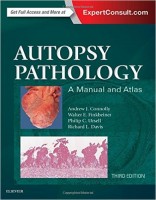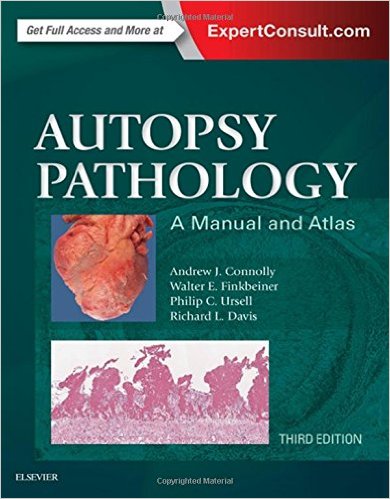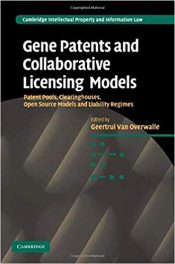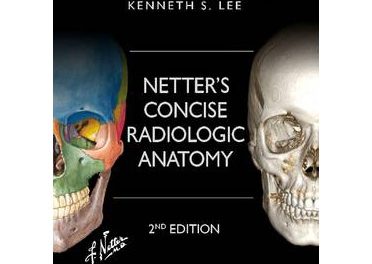 Authors: Andrew J. Connolly, MD; Walter E. Finkbeiner, MD; Philip C. Ursell, MD and Richard L. Davis, MD
Authors: Andrew J. Connolly, MD; Walter E. Finkbeiner, MD; Philip C. Ursell, MD and Richard L. Davis, MD
Publisher: Elsevier – 392 pages
Book Review by: Nano Khilnani
Autopsy is the art and science of postmortem examinations, and this book is useful for practicing pathologists, pathology assistants, trainees, students of pathology, and anyone else interested. This medical specialty, commonly known as the causal study of disease, has many other subspecialties, besides autopsy pathology.
Among other subspecialties are: anatomical pathology (with several sub-sub specialties relating to different parts of the body), clinical pathology, forensic pathology, molecular pathology, oral and maxillofacial pathology, and psychopathology.
The range of subjects this book on autopsy pathology covers is large, and we name its 16 chapters below to give you a broad overview of what you will find within its nearly 400 pages:
- The Autopsy – Past and Present
- Legal, Social, and Ethical Issues
- Autopsy Biosafety
- Basic Postmortem Examination
- Postmortem Examination of Fetuses and Infants
- Special Dissection Procedures
- Autopsy Photography and Radiology
- Microscopic Examination
- Microscopic Findings
- Supplemental Laboratory Studies
- The Autopsy Report
- Sudden Death Due to Natural Causes
- Multiple Organ Dysfunction and Sepsis
- Death Certification
- Quality Management
- Atlas of Gross Autopsy Pathology
Appendix A: Description of Gross Autopsy Findings
Appendix B: Measures, Weights, and Assessment of Growth and Development
For your benefit, all the content of this printed book as outlined above can be viewed online by the purchaser. You can activate the eBook version of this title at no extra charge, and view it on the screen of almost any Internet-enabled device at anytime and anywhere.
Expert Consult eBooks give you the power to browse and find content, view enhanced images, and share notes and highlights – both online and offline.
To unlock your eBook:
- Visit www.expertconsult.inkling.com/redeem
- Scratch off the code on the inside front cover your book
- Type that code into Enter Code box
- Click Redeem
- Log In or Sign Up
- Go to My Library
For technical assistance, email: expertconsulthelp@elsevier.com or call 1-800-401-9962 in the United States or-1-313-447-8200 if you are outside the U.S.
While most people see the obvious benefit of autopsy pathology as a means to studying the specific and detailed causes of diseases and death, there are those who question its purpose. In chapter 1, The Autopsy – Past and Present, the various benefits of the autopsy are presented and discussed under the heading The Objectives of the Autopsy. We briefly mention them here:
- Benefits to Physicians and Health Care Organizations: the establishment of final diagnoses and determination of the cause of death. This is done by correlating physical and laboratory findings with the pathologic changes of disease. In sum, “the autopsy is the gold standard for evaluating the accuracy of a diagnosis and the outcome of therapy,” write the authors
- Benefits to the Family of the Diseased: in an autopsy, the pathologists can identify and define hereditary or contagious diseases. If a family member dies of a heart attack due to clogged arteries, which was the same cause of his father’s death, this information is vitally important to others in the family who should also undergo a series of cardiac tests, study the results, and take precautions before becoming victims themselves.
- Benefits to Public Health: public health surveillance can be achieved through: detection of contagious diseases, identification of environmental hazards, and contribution of accurate vital statistics. These three types of records can be established with autopsies. This can be enabled when the pathologist shares information with public health officials, who in turn speaks to members of the news media.
- Benefits to Medical Education: Observing a deceased patient in detail, looking at the areas of disease where and how an infection spread for example, is a very valuable method in medical education. This process is real, much better and more effective than seeing full-color photos in a medical textbook. Observing an autopsy is not only useful for the medical student to learn pathology, but also anatomy, histology, and surgery.
- Benefits to Medical Discovery and Applied Clinical Research: Data from autopsies support as solid evidence as causes of disease and death in the areas of cardiology, hematology, neuroscience, oncology, pulmonology, and other specialties. Molecular examination techniques used in postmortem examinations have identified diseases related to new, emerging infectious agents.
- Benefits to Basic Biomedical Research: tissues taken from bone, brain, internal organs, muscle, skin, and other parts of the dead patient are helpful for establishing cell and organ cultures, biochemical analysis, morphologic studies, and xeno-transplantation. In short, for enhancing research and understanding the diseases that led to eath. Examining pathologic processes at cellular and molecular levels give us clues to underlying causes.
For this book, you can get even more valuable information online from another useful allied website – www.ClinicalKey.com, whose aim is to provide smarter, faster, and better patient care.
This search engine of Elsevier Saunders is specially designed for doctors by providing them three core components:
- Comprehensive Content – the most current, evidence-based answers available for every medical and surgical specialty.
- Trusted Answers – content supplied by Elsevier, the world’s leading provider of health and science information.
- Unrivaled Speed to Answer – faster, more relevant clinical answers, so you can spend less time searching and more time caring for your patients.
Editors:
Andrew J. Connolly, MD is Associate Professor in the Department of Pathology at Stanford University, in Stanford, California.
Walter E. Finkbeiner, MD is Professor and Vice Chair of the Department of Pathology at University of California San Francisco; Chief of Pathology at the Department of Anatomic Pathology at San Francisco General Hospital; and Chief of Pathology at the SFGH Endowed Chair in San Francisco, California.
Philip C. Ursell, MD is Professor in the Department of Pathology at the University of California San Francisco; Director, Autopsy Service at Moffitt-Long Hospital in San Francisco, California.
Richard L. Davis, MD is Professor Emeritus in the Department of Pathology at the University of California San Francisco, in San Francisco, California.






